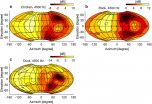(Press-News.org) December 11, 2014 - Hospitals with robotic surgical systems are more likely to perform "nephron-sparing" partial nephrectomy--a recommended alternative to removal of the entire kidney--in patients with kidney cancer, reports a study in the December issue of Medical Care. The journal is published by Lippincott Williams & Wilkins, a part of Wolters Kluwer Health.
"Hospital acquisition of the surgical robot is associated with greater proportion of partial nephrectomy, an underutilized, guideline-encouraged procedure," write Dr Ganesh Sivarajan of New York University Langone Medical Center and colleagues. Their study suggests an unexpected benefit of surgical robots--a costly technology that has been criticized for rapid adoption without evidence of patient benefit.
Surgical Robots Affect Partial Nephrectomy Rate
The standard treatment for kidney cancer has been radical nephrectomy: removal of the entire kidney. But in recent years, partial nephrectomy--surgery to remove the cancer, while preserving as much functioning kidney as possible--has been recommended.
This "nephron-sparing" approach is just as effective in controlling the kidney cancer, but with lower long-term rates of cardiovascular disease, kidney failure, and death. Partial nephrectomy is a technically challenging and "under-utilized" procedure; most patients still undergo total nephrectomy.
Dr Sivarajan and colleagues examined whether acquisition of the surgical robot, which affords surgeons improved magnification and manual dexterity, led to increased use of partial nephrectomy. Using linked nationwide databases, they identified more than 21,500 patients in seven states who underwent surgery for kidney cancer in 2001, 2005, or 2008.
They found that hospitals with surgical robots performed more partial nephrectomies. For hospitals that acquired a robot between 2001 and 2004, the number of partial nephrectomies increased by 30 percent in 2005, and 35 percent in 2008. For hospitals acquiring a robot between 2005 and 2008, the increase was smaller (15.5 percent) but still significant.
'Early Adopters' of New Technologies May Find Unexpected Benefits
Surgical robots were approved for use in prostate cancer surgery in 2001, and their use has expanded rapidly since then. There has been criticism about the high use and costs of robot-assisted surgery, in the absence of data showing that it improves prostate cancer outcomes.
Meanwhile, robots are being used for many different types of surgical procedures, despite a lack of evidence showing benefit to patient care. Regional-level studies have suggested that the availability of surgical robots has led to increased use partial nephrectomy.
The new study shows a similar pattern nationwide, with hospitals performing more partial nephrectomies in the years after acquiring a surgical robot. The association is significant even considering the background trend: a gradual increase in nephron-sparing surgery.
Dr Sivarajan and colleagues believe their study has implications for the adoption of new medical technology. They write, "The unexpected benefits of surgical robot acquisition on the management of renal tumors are an example of 're-invention' or the manner in which a new innovation is altered in the process of its adoption and implementation after its initial development."
The greatest increases in partial nephrectomy occurred among the "earliest adopters"--suggesting that even if the benefits aren't immediately apparent, "[T]here might be some benefit to ensuring access to new technology for select institutions." Dr Sivarajan and colleagues add, "While much research and data are clearly necessary prior to widespread adoption, policy mechanisms... should remain in place to encourage some degree of limited technology adoption, even if the technology may not immediately appear cost-effective."
Click here to read "The Effect of the Diffusion of the Surgical Robot on the Hospital-level Utilization of Partial Nephrectomy."
INFORMATION:
About Medical Care
Rated as one of the top ten journals in health care administration, Medical Care is devoted to all aspects of the administration and delivery of health care. This scholarly journal publishes original, peer-reviewed papers documenting the most current developments in the rapidly changing field of health care. Medical Care provides timely reports on the findings of original investigations into issues related to the research, planning, organization, financing, provision, and evaluation of health services. In addition, numerous special supplementary issues that focus on specialized topics are produced with each volume. Medical Care is the official journal of the Medical Care Section of the American Public Health Association.
About Wolters Kluwer Health
Wolters Kluwer Health is a leading global provider of information, business intelligence and point-of-care solutions for the healthcare industry. Serving more than 150 countries worldwide, clinicians rely on Wolters Kluwer Health's market leading information-enabled tools and software solutions throughout their professional careers from training to research to practice. Major brands include Health Language®, Lexicomp®, Lippincott Williams & Wilkins, Medicom®, Medknow, Ovid®, Pharmacy OneSource®, ProVation® Medical and UpToDate®.
Wolters Kluwer Health is part of Wolters Kluwer, a market-leading global information services company. Wolters Kluwer had 2013 annual revenues of €3.6 billion ($4.7 billion), employs approximately 19,000 people worldwide, and maintains operations in over 40 countries across Europe, North America, Asia Pacific, and Latin America.maintains operations in over 40 countries across Europe, North America, Asia Pacific, and Latin America. Wolters Kluwer is headquartered in Alphen aan den Rijn, the Netherlands. Its shares are quoted on Euronext Amsterdam (WKL) and are included in the AEX and Euronext 100 indices. Wolters Kluwer has a sponsored Level 1 American Depositary Receipt program. The ADRs are traded on the over-the-counter market in the U.S. (WTKWY).
Follow our official Twitter handle: @WKHealth.
An interstellar mystery of why stars form has been solved thanks to the most realistic supercomputer simulations of galaxies yet made.
Theoretical astrophysicist Philip Hopkins of the California Institute of Technology (CalTech) led research that found that stellar activity -- like supernova explosions or even just starlight -- plays a big part in the formation of other stars and the growth of galaxies.
"Feedback from stars, the collective effects from supernovae, radiation, heating, pushing on gas, and stellar winds can regulate the growth of galaxies and explain why ...
Unlike mammals, birds have no external ears. The outer ears of mammals play an important function in that they help the animal identify sounds coming from different elevations. But birds are also able to perceive whether the source of a sound is above them, below them, or at the same level. Now a research team from Technische Universität München (TUM) has discovered how birds are able to localize these sounds, namely by utilizing their entire head. Their findings were published recently in the PLOS ONE journal.
It is springtime, and two blackbirds are having ...
NEW YORK, NY - Patients with operable kidney cancers were more likely to have a partial nephrectomy -- the recommended treatment for localized tumors -- when treated in hospitals that were early adopters of robotic surgery, according to a new study.
Researchers from NYU Langone Medical Center and elsewhere, publishing online December 11 in the journal Medical Care, report that by 2008, hospitals that had adopted robotic surgery at the start of the current century (between 2001 and 2004) performed partial nephrectomies in 38% of kidney cancer cases compared to late adopters ...
Novel research reveals that the risk of acute gout attacks is more than two times higher during the night or early morning hours than it is in the daytime. The study published in Arthritis & Rheumatology, a journal of the American College of Rheumatology (ACR), confirms that nocturnal attacks persist even among those who did not consume alcohol and had a low amount of purine intake during the 24 hours prior to the gout attack.
The body produces uric acid from the process of breaking down purines--natural substances in cells in the body and in most foods--with especially ...
Parkinson's disease sufferers have a different microbiota in their intestines than their healthy counterparts, according to a study conducted at the University of Helsinki and the Helsinki University Central Hospital (HUCH).
"Our most important observation was that patients with Parkinson's have much less bacteria from the Prevotellaceae family; unlike the control group, practically no one in the patient group had a large quantity of bacteria from this family," states DMSc Filip Scheperjans, neurologist at the HUCH Neurology Clinic.
The researchers have not yet ...
A team of researchers led by North Carolina State University has found that stacking materials that are only one atom thick can create semiconductor junctions that transfer charge efficiently, regardless of whether the crystalline structure of the materials is mismatched - lowering the manufacturing cost for a wide variety of semiconductor devices such as solar cells, lasers and LEDs.
"This work demonstrates that by stacking multiple two-dimensional (2-D) materials in random ways we can create semiconductor junctions that are as functional as those with perfect alignment" ...
Researchers have found new evidence that explains how some aspects of our personality may affect our health and wellbeing, supporting long-observed associations between aspects of human character, physical health and longevity.
A team of health psychologists at The University of Nottingham and the University of California in Los Angeles carried out a study to examine the relationship between certain personality traits and the expression of genes that can affect our health by controlling the activity of our immune systems.
The study did not find any results to support ...
Could there finally be tangible evidence for the existence of dark matter in the Universe? After sifting through reams of X-ray data, scientists in EPFL's Laboratory of Particle Physics and Cosmology (LPPC) and Leiden University believe they could have identified the signal of a particle of dark matter. This substance, which up to now has been purely hypothetical, is run by none of the standard models of physics other than through the gravitational force. Their research will be published next week in Physical Review Letters.
When physicists study the dynamics of galaxies ...
In the hunt for better knowledge on the aging process, researchers from Lund University have now enlisted the help of small birds. A new study investigates various factors which affect whether chicks are born with long or short chromosome ends, called telomeres.
The genetic make-up of our cells consists of genes lined up on chromosomes. The ends of the chromosomes are called telomeres, and they protect the chromosomes from sticking to each other. The longer the telomeres, the longer time the chromosomes are able to function. And conversely, the shorter these ends, ...
WEST LAFAYETTE, Ind. - Invasive plant and animal species can cause dramatic and enduring changes to the geography and ecology of landscapes, a study from Purdue University and the University of Kentucky shows.
A review of studies on how life forms interact with and influence their surroundings concluded that invasive species can alter landscapes in myriad ways and with varying degrees of severity. These changes can be quick, large-scale and "extremely difficult" to reverse, said study author Songlin Fei, a Purdue associate professor of quantitative ecology.
"Invaders ...


